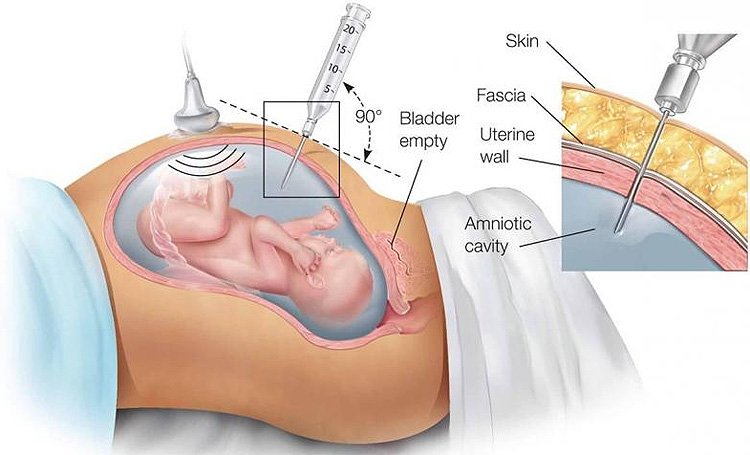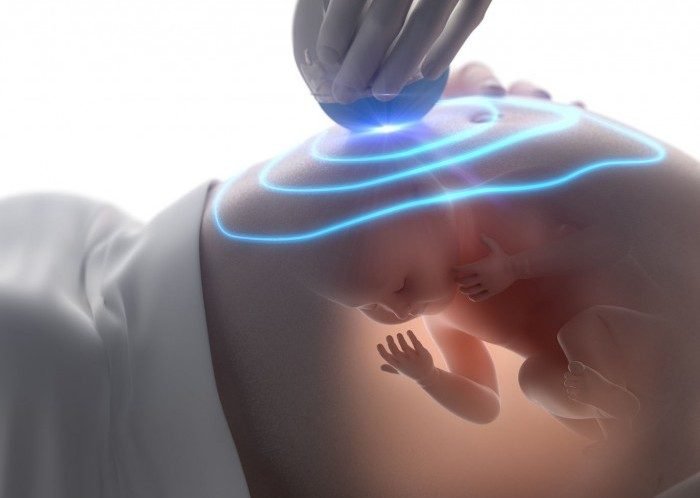Her digestive system is also well on its way to being self-sustaining, as her intestines grow and move into her abdomen, and her kidneys begin to release urine into her bladder. Further up, her brain synapses are becoming more advanced, and the face that you’ll soon know and love starts to take shape. Some more subtle changes are also beginning to occur, as her bone marrow begins to produce protective white blood cells and her pituitary gland begins making hormones.
Your family / personal medical history or perhaps an ultrasound result may suggest to your doctor that you have a slightly greater chance of giving birth to an infant with a birth defect. Therefore your doctor may suggest that you undergo an amniocentesis, a test used to detect some foetal abnormalities.
Around week 12, you may want to talk to your health care professional about whether you should receive an amniocentesis, which is a test to detect any genetic disorders. The procedure is usually performed between weeks 14 and 20 of pregnancy and can be used later in your third trimester if there is a reason do to so.
During an amniocentesis, your health care provider will use an ultrasound to find a safe location from which he or she can extract some fluid from the amniotic sac using a needle. The collected liquid contains cells shed by your baby, and so, through a lab test, your physician may be able to determine whether any abnormalities are present.
An amniocentesis can tell you whether your baby has neural tube defects, like spina bifida, or chromosomal conditions like Down syndrome. When performed later in pregnancy, the test is usually meant to look for lung development. Additionally, amniocentesis is sometimes done to determine paternity. Meanwhile, your little one has moved from your pelvis to your lower abdomen, hopefully taking some of the pressure off your bladder. You can probably feel your uterus if you gently push the bulge between your hip bones.
What Is An Amniocentesis?

An amniocentesis (or amnio for short) is a test in which a small sample of liquor (from your baby’s water) is taken from around the developing baby. A needle is passed through the abdomen, the wall of the uterus and into the liquor surrounding the baby without touching the baby or the placenta. Approximately 15mls of fluid is taken, this amount being small compared with the total amount of fluid present (at least 150mls) at the time of the test at 16 weeks.
Amniocentesis is an invasive, diagnostic antenatal test. It involves taking a sample of amniotic fluid in order to examine fetal cells found in this fluid. Amniocentesis is usually reserved for those women considered at higher risk of carrying a fetus with a chromosomal or genetic abnormality.
The amniotic fluid extracted contains cells from the amnion and fetal skin, lungs and urinary tract, which can then undergo chromosomal, genetic, biochemical and molecular biological analysis. Annually about 5% of the pregnant population (approximately 30,000 women in the UK) are offered an invasive, prenatal diagnostic test, usually either amniocentesis or chorionic villus sampling (CVS).
Timing of Amniocentesis
a) Early (between 12 and 14+6 weeks of gestation):
This is not recommended, as it is associated with an increased risk of miscarriage and higher incidence of talipes.
b) Mid-trimester (between 15 and 18 weeks of gestation):
This is the most common time for the procedure.
c) Third trimester
May be undertaken for late karyotyping and for detection of fetal infection in prelabour rupture of the membranes. Amniocentesis is an invasive test posing risk to fetus and mother. It is therefore not used as a screening test.
Genetic counselling
Genetic counselling should ideally be offered prior to any pregnancy, when there is a family history of a condition which might be diagnosed either by amniocentesis or CVS. It is clearly important to avoid unnecessary invasive testing in pregnancy where possible.
Diagnostic testing should be provided within the context of informed consent and autonomy, both about the conditions being tested and about the implications for the continuation of the pregnancy. Pre- and post-test genetic counselling are both indicated.
Risks and complications of amniocentesis
- Discomfort (uterine cramping).
- Vaginal bleeding (about 2%).
- Amniotic fluid leakage (about 1.7%).
- Maternal rhesus sensitisation in susceptible pregnancies (also true for CVS).
- Amnionitis (about 0.1%).
- Miscarriage risk.
-
- An increased risk of mid-trimester miscarriage compared with the background risk has generally been quoted as about 0.5-1%.
- A systematic review and meta-analysis, which included only studies published since 2000, therefore reflecting current practice, suggests the procedure-related risks are much lower at 0.1% and may even simply reflect the pregnancy characteristics of the women concerned rather than the procedure itself.
- The procedure-related risk in twin pregnancies is higher than in singleton pregnancies and is about 1%.
- Failure of cell culture from 1% up to 5% if performed under 12 weeks of gestation.
- Very experienced surgeons (more than100 procedures per year) may have higher success rates and lower procedure-related miscarriages.
- Anxiety for parents, due to lateness of diagnosis (this may make decisions about termination of pregnancy very difficult).
Who Is Offered One?
Women of 37 years and over at the projected time of birth Women who have already had a child with a problem such as Down’s Syndrome or Spina Bifida Occasionally amniocentesis is done for other reasons. These include parents who are known to have a chromosomal abnormality or who are known to be at risk of having a baby with one of a number of rare abnormalities of their metabolism.
Why Are Women Over The Age Of 37 Offered An Amnio?
As the age of the mother increases the chances of her having a baby with a chromosomal abnormality also increases. The most common chromosome abnormality is Downs Syndrome. Between 37 and 40 years of age the chance of having a baby with an abnormality is approximately 1 in 100. Beyond the age of 40 years this chance increases even further. The incidence of Spina Bifida does not seem to be correlated with age.
What Will Happen On The Day?
It is important that the mother’s bladder is full; this lifts the uterus up out of the pelvis making it easier to see the baby with ultrasound. The ultrasound scan is performed prior to the amniocentesis so that the pregnancy and the placenta can be checked and to determine whether there is a singleton or twin pregnancy.
The ultrasound scan is quite painless and merely involves spreading a little warm gel over the lower abdomen and then moving an ultrasound probe gently over the skin surface. After the ultrasound scan has been performed, the abdomen is cleaned and the needle is inserted into the uterus. The needle is watched all the time on the ultrasound screen. It then only takes about one minute to draw up 15-20mls of fluid into a syringe.
After removing the needle and again checking the baby, the mother is able to get dressed and go home. Almost without exception, patients experience far less discomfort from the test than they had expected. Any discomfort felt is usually similar to that felt for a simple blood test. It is recommended that for the rest of the day things are taken quietly, but after this to return to a usual routine.
What Tests Are Performed On The Fluid Taken?
An estimate of the amount of a particular protein (alpha feto-protein). There are usually large amounts of this protein present in the fluid if a baby has a defect called Spina Bifida. The second test is carried out on the cells which are present in the fluid. The chromosomes of these can be examined and in this way it is possible to detect whether the baby has Downs Syndrome or any other less common chromosome problems. The sex of the baby is also determined.
How Long Will The Test Results Take?
The results of the Spina Bifida test are usually available after one week. Your doctor would not normally inform you of this result unless there was a problem. However the ultrasound examination would detect babies with Spina Bifida. The chromosome test for Downs Syndrome takes from 10 to 21 days because the cells are required to grow in a laboratory for a period of days.

The laboratory will send the results directly to your doctor. It will be the doctor looking after you and your pregnancy who will tell you the results of the amniocentesis. Finally, it is important to realise that while a combination of amniocentesis (with a 99.9% accuracy) and a thorough 18-20 week ultrasound goes a long way to ensuring the baby is normal, it does not guarantee that every possible abnormality has been excluded.
Is It Worth The Risk?
The decision to have an amniocentesis is a very personal and difficult one to make. If you’ve had an amniocentesis before, BellyBelly would like to hear from you. What would your advice be to others in the same position? Email us your comments on this topic, and we will post them here for others to read, anonymously if you so wish.
The small risks associated with the procedure mean that some women who are clear that they would not wish to terminate an affected pregnancy choose not to have the test.
An amniocentesis is usually recommended for women who are at increased risk for having a child with birth defects. This includes women who:
- will be 35 or older when the child is born
- had a screening test that indicated a possible problem
- previously gave birth to a baby with birth defects
- have a family history of genetic disorders.
Because there is a very slight chance about 1 in every 200 to 400 of complications (including miscarriage) stemming from amniocentesis, you’ll want to take time making the decision of whether to obtain one.
Even if you are in the higher risk category, you do not have to get an amniocentesis; the decision is yours. Do as much research as you can, and be sure to talk about any concerns you may have with your health care provider and your partner.
For more information visit us our website: https://www.healthinfi.com
0 200Review
-
Good Information




No Comments